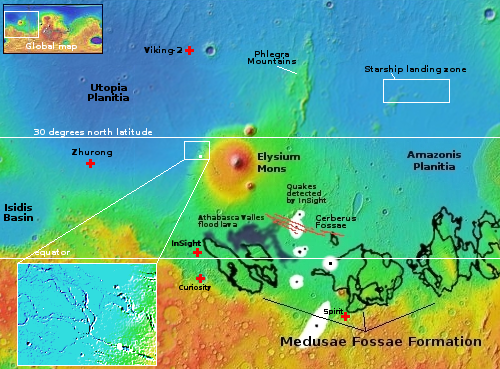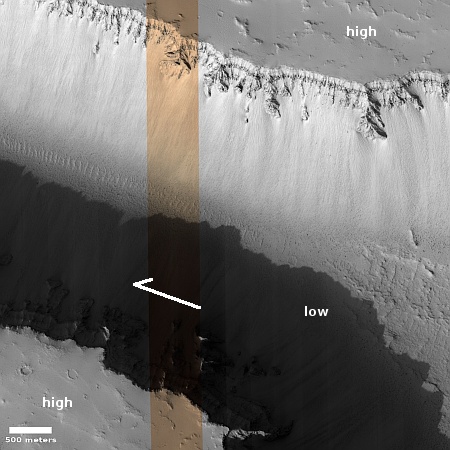A channel of ice, water, or lava?
Cool image time! The picture to the right, rotated, cropped, reduced, and sharpened to post here, was taken on July 16, 2024 by the high resolution camera on Mars Reconnaissance Orbiter (MRO). It shows one small section of a Martian canyon approximate 750 miles long and dubbed Elysium Fossae.
The canyon walls at this spot rise about 3,300 to 3,800 feet from the canyon floor. The canyon itself is thought to be what geologists call a graben, initially formed when the ground was pulled apart to form a large fissure.
That’s what happened at this location, at least to start. This canyon is on the lower western flank of the giant shield volcano Elysium Mons. The cracks, which radiate out outward from the volcano’s caldera, likely formed when pressure from magma below pushed upward, splitting the surface.
That formation process however does not fully explain everything.

The white dot on the overview map to the right marks the location, on the edge of Elysium Mons’ lower slopes and near where the northern lowland plains of Mars begin. If you look at the inset, which I have enhanced to bring out the western tributaries of Elysium Fossae, you can see that once this fissure reaches those lowland plains it no longer looks like a graben (which are generally very straight, following fault lines). Instead, it resembles the branching tributary system of a river, though the flow direction is downhill into the smaller branches, the opposite of what happens with such systems on Earth.
So, what formed the entire system? The straight fissures higher up on the volcano suggest that after the crack appeared, lava vented out of it to flow downhill and widen it. The tributary system below however suggests that either ice or water carved the many branches.
It is also possible that lava, ice, and water all contributed, either at separate times or their action interweaving in a complex dance.
On Christmas Eve 1968 three Americans became the first humans to visit another world. What they did to celebrate was unexpected and profound, and will be remembered throughout all human history. Genesis: the Story of Apollo 8, Robert Zimmerman's classic history of humanity's first journey to another world, tells that story, and it is now available as both an ebook and an audiobook, both with a foreword by Valerie Anders and a new introduction by Robert Zimmerman.
The print edition can be purchased at Amazon or from any other book seller. If you want an autographed copy the price is $60 for the hardback and $45 for the paperback, plus $8 shipping for each. Go here for purchasing details. The ebook is available everywhere for $5.99 (before discount) at amazon, or direct from my ebook publisher, ebookit. If you buy it from ebookit you don't support the big tech companies and the author gets a bigger cut much sooner.
The audiobook is also available at all these vendors, and is also free with a 30-day trial membership to Audible.
"Not simply about one mission, [Genesis] is also the history of America's quest for the moon... Zimmerman has done a masterful job of tying disparate events together into a solid account of one of America's greatest human triumphs."--San Antonio Express-News
Cool image time! The picture to the right, rotated, cropped, reduced, and sharpened to post here, was taken on July 16, 2024 by the high resolution camera on Mars Reconnaissance Orbiter (MRO). It shows one small section of a Martian canyon approximate 750 miles long and dubbed Elysium Fossae.
The canyon walls at this spot rise about 3,300 to 3,800 feet from the canyon floor. The canyon itself is thought to be what geologists call a graben, initially formed when the ground was pulled apart to form a large fissure.
That’s what happened at this location, at least to start. This canyon is on the lower western flank of the giant shield volcano Elysium Mons. The cracks, which radiate out outward from the volcano’s caldera, likely formed when pressure from magma below pushed upward, splitting the surface.
That formation process however does not fully explain everything.

The white dot on the overview map to the right marks the location, on the edge of Elysium Mons’ lower slopes and near where the northern lowland plains of Mars begin. If you look at the inset, which I have enhanced to bring out the western tributaries of Elysium Fossae, you can see that once this fissure reaches those lowland plains it no longer looks like a graben (which are generally very straight, following fault lines). Instead, it resembles the branching tributary system of a river, though the flow direction is downhill into the smaller branches, the opposite of what happens with such systems on Earth.
So, what formed the entire system? The straight fissures higher up on the volcano suggest that after the crack appeared, lava vented out of it to flow downhill and widen it. The tributary system below however suggests that either ice or water carved the many branches.
It is also possible that lava, ice, and water all contributed, either at separate times or their action interweaving in a complex dance.
On Christmas Eve 1968 three Americans became the first humans to visit another world. What they did to celebrate was unexpected and profound, and will be remembered throughout all human history. Genesis: the Story of Apollo 8, Robert Zimmerman's classic history of humanity's first journey to another world, tells that story, and it is now available as both an ebook and an audiobook, both with a foreword by Valerie Anders and a new introduction by Robert Zimmerman.
The print edition can be purchased at Amazon or from any other book seller. If you want an autographed copy the price is $60 for the hardback and $45 for the paperback, plus $8 shipping for each. Go here for purchasing details. The ebook is available everywhere for $5.99 (before discount) at amazon, or direct from my ebook publisher, ebookit. If you buy it from ebookit you don't support the big tech companies and the author gets a bigger cut much sooner.
The audiobook is also available at all these vendors, and is also free with a 30-day trial membership to Audible.
"Not simply about one mission, [Genesis] is also the history of America's quest for the moon... Zimmerman has done a masterful job of tying disparate events together into a solid account of one of America's greatest human triumphs."--San Antonio Express-News


